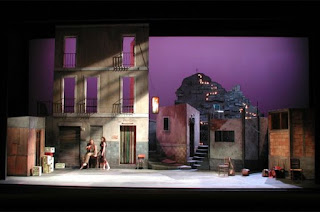30 Weeks - Culminating in a full blown musical West Side Story at Hostos Community College in June. I have some plans for how to deal with the Union Stagehands (school hasn't had very positive experiences with them in the past) - the choreography of moving the set around will be an important piece of this beginning mid-May. All of this is also subject to change, as I haven't spent time with this particular group of young people yet.
Main interest of the school staff person I'm working with - for young people to get a clear understanding of how all the aspects of a project (like a play) are equally important to manifest a complete vision - So that gives me a clear baseline for how to structure the layers of learning. We also have until June to build our set, so the first semester will be looking at the basics and developing the skills and components that will eventually be utilized in our set design, so when we get to the build part second semester - they will be working from/embodying their own knowledge and experience. *I will also be maintaining individual folders for each student with portfolio images - part of what the Art Director of the school is hoping to achieve
The Parts (split into months so we have a time container)
1. October/Makeup Design
24th - old person makeup/wig design
27th - Anatomy of a Villian - look at famous ones, like Scar from Lion King on Broadway. Design our own Villians based on what we learn - head pieces/jewelry etc as well
31st - Design a makeup based character transformation (possibly for your halloween costume) - makeup in context to personal desire
2. November/Character Development - We might do this in pairs or teams, possibly different characters in the same world we build together. There are a lot of dates in this month, so we will slide into set design based on our characters/narrative
2nd - Looking at well known characters and breaking down the physical/costume choices that help tell their story on different levels, especially characters that have some kind of transformation.
9th - Work together to create a character and enough of a story that we know important details - so we can design a costume and makeup look. Scraps will be available to flesh out ideas - we will be working from these later, so I'll probably have a set of questions that need to be asked.
14th - Construction of the costume pieces from random/leftover/scraps etc
16th - Continue construction, adding paint and other flourishes once the initial structure is set up
21st - Presenting our different character representations, talking through what is working vs what might be missing - possibly a full design presentation for available adults in the building. Begin discussion about what kind of environment these characters should live in (depending on the time)
28th - Begin Design process for our story environment, figuring out which teams will be responsible for design various parts
30th - Design continued, ready to begin construction of model for December
3. December/Set Construction Fundamentals
5th - Using cardboard to translate our drawings into small version of the different pieces
7th - Paint techniques in miniature to make our cardboard look realistic
12th - Construction and painting continued, mini characters made for lighting models and fotos
14th - Filming/making short animatic with lighting and sound cues so we get a picture of how all the parts work together
19th - Making gingerbread houses (can take home)
21st - Working together to construct a full gingerbread set and maybe make a mini movie
4. January/Begin looking at West Side Story
2nd - Immigration in the 50's/US and NY relationship with Puerto Rico and the social impacts (prejudice, garment district, housing at the time as a key feature for the set) - which are the basis for the narrative of West Side Story - talking about how those realities might create the characters and the relationships between them, looking at the environment as a character/extension of the people who inhabit it
4th - Designing, looking at what the script calls for and breaking up the props/costume design/different sets into groups or a timeline - now that the young people have a sense of what will be needed, let them choose where they enjoyed the most, let them set the timeline up etc
9th - Design continued
11th - Check in as a group, mini presentations - look at whats working, what still needs to get done. Keep working - models and mockups beginning to happen with scraps
16th - Models in full swing, including painted aspects, miniature versions of our characters etc
18th - Finish everything
23rd - Present to other Tuesday TA group? (sharing, other adults, dy staff present)
25th - Present to other Thursday Group? (sharing, other adults, dy staff present)
The 30th of January begins the second semester, with approval, actual set building can begin - maybe each month is a different part of the set being actualized, including props and costumes - Bridal Shop, Alley Way etc etc
Some initial Old people makeup design references:











No comments:
Post a Comment